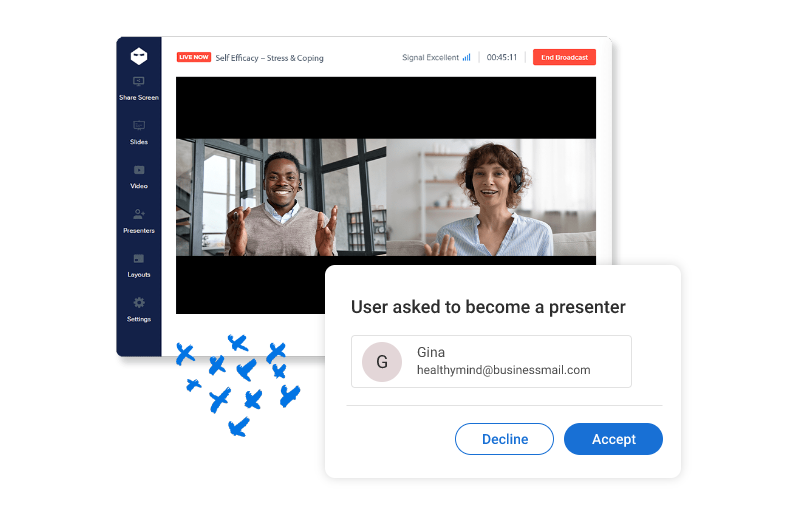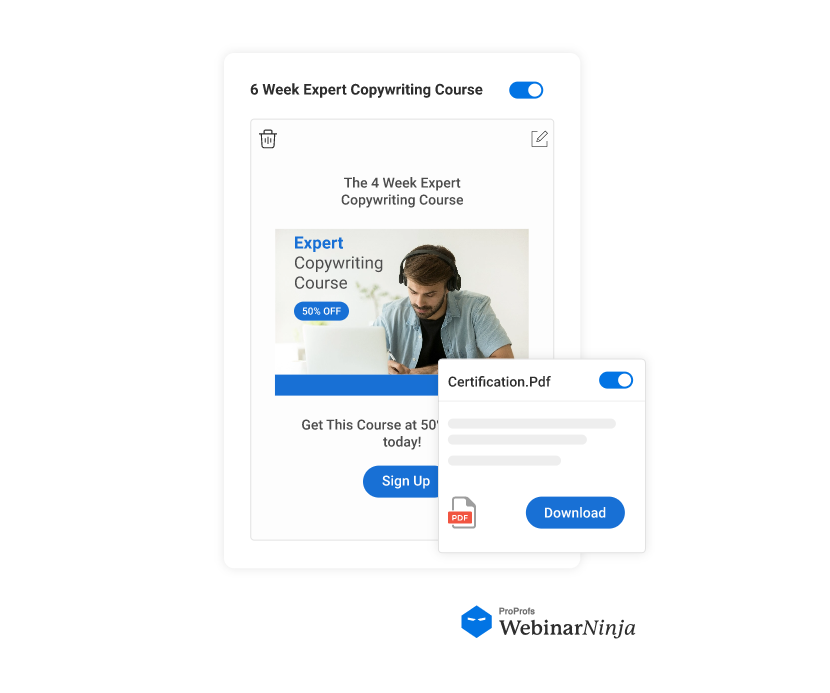You have the skills to coach online. You just need to find online coaching clients.
Or more of them, anyway.
You know how to help people with fitness, life, business, or something else. The problem is finding those people and keeping a steady stream of them coming in month after month.
What you need to build an online coaching business is a reliable, low-maintenance coaching and course client funnel.
This post will show you how to create one, taking inspiration from the best online coaches.
Let’s jump in.
What Do the Best Online Coaches Say?
In his (awesome) book Book Yourself Solid, Michael Port identifies three problems online coaches tend to have:
- Not having enough online coaching clients
- Having the wrong clients, the kind who don’t put their effort in
- Feeling like you can’t deliver results because those (wrong) clients aren’t successful
Although Book Yourself Solid came out years ago, the three problems above are still the most common I hear about. Experienced, qualified coaches get stuck because they can’t consistently bring in new leads and online coaching clients.
This brings us to another famous coach …
This is the coach’s coach, the guy the coaches turn to for coaching: Taki Moore. Over the years, I’ve absorbed many of his lessons and adapted them to my own approach. So, when I advise other entrepreneurs, I’m usually (partially) stealing from him.
In his book Million Dollar Coach, Moore boils successful coaching down to a 3-step process:
- Attract: Identify the right leads and speak directly to them.
- Convert: Prove your value and turn leads into online coaching clients.
- Deliver: Create success stories and let your happy clients spread the word.
I’ve reinterpreted Moore’s approach, tailoring it more specifically for use with webinars (though Moore is a big fan of webinars as a marketing and conversion tool, too). Here’s how it’s done:
How to Attract Quality Leads for Online Coaching
We start with attraction. Who are the “right” leads, and how do you get them? I break this step down into three smaller steps:
- Define the “right” leads
- Create value for them
- Promote that value to fill the top of your funnel
Let’s take one step at a time.
1. Define the “right” leads
Take some time to do this. Before you do anything else, you have to nail down who would make your ideal client.
This might include demographic info like age and income. Only you can create your ideal online coaching client profile, but be as specific as possible.
For example, my business coach only works with SaaS companies whose monthly revenue exceeds a certain amount. He doesn’t work with beginners or multi-billion dollar CEOs. His coaching is designed for one kind of student.
Yours should be, too.
The easiest way to get started is to ask yourself three questions about your ideal client:
A. Who are they?
This is where you think about demographics, experience, situation, etc.
B. Why are they stuck?
What can you do that would move someone from one level to the next? Again, think of how my coach only works with successful (but not too successful) SaaS founders. He specializes in the transition from general success to “big-time” success.
C. What have they tried already?
Anticipate their objections so you can show how you’re different. Your ideal client may think, “Ugh, I already tried counting macros; it just took up too much time.” You coach people in eating intuitively or making incremental changes, so you’re a perfect fit.
Let’s use me as an example of an ideal online coaching client. Yoga teachers, listen up! You might just recruit me.
I want yoga in my life, but I’m stuck and could use a coach.
- Who am I?
I’m over 40. I consider myself an athlete. I work out consistently, I love sports, and I’m motivated. I want yoga in my life because I know it’ll help me stay active into middle and old age.
- Why am I stuck?
I’m tall, and not young anymore. Yoga … hurts! I’m not flexible enough, and I have a high center of gravity. Yoga is more challenging for me than it is for all the 5′ 10″ 20-somethings I see in the studio. Help!
- What have I tried before?
Just jumping into regular yoga classes. I’ve tried it! And I found it way too challenging for my age, body type, and experience level. As a competitive athlete, that makes me feel defeated and frustrated.
Can you help me? If so, there are probably hundreds or thousands of me out there, just waiting for you to coach us! If not, who can you help? Use the above questions to come up with a specific answer.
2. Create (Free) Value
Now that you know who you’re targeting, it’s time to create something valuable for them. It has to be something irresistible to exactly the type of person you want to market to.
And it has to be free.
This isn’t for sale. You’re gonna share something that gives people a win and proves your value … something that gives them confidence in you but makes them want to know more, too. So, what might that be? It shouldn’t cost you much to produce, but it should dramatically demonstrate your value.
The best solution: A PDF and on-demand automated webinar.
I’ll explain with an example. Let’s say you’re a meditation coach.
- You create a short (as in 1-3 pages) PDF with a few breathing techniques. Choose techniques that work quickly to produce a noticeable result.
- Then, film a brief video of yourself teaching these techniques. Nothing over 10 minutes.
- Finally, turn that video and PDF into an automated (as in pre-recorded) webinar lesson. This webinar is free and available to watch whenever. WebinarNinja also lets you include the PDF as an in-webinar download using our “Handouts” feature.
- In the webinar, include a Call to Action (CTA) encouraging viewers to sign up for a free live webinar, where you’ll tell them how to continue their training.
Aspiring meditators find out about your automated webinar (we’ll discuss how later) and take your lesson at their convenience.
A good automated webinar is a lead-generating machine! Because people still have to register, you’ll get their email addresses and grow your list. Because it’s a “Watch Now” or “on demand” lesson, it brings in leads 24/7, regardless of schedules and time zones.
That said, you’re not selling anything on the automated webinar. The goal is simply to get them onto the live webinar. The live webinar will include more guidance, a chance to ask you questions in real time, and an offer for your coaching or course.
You will be completely upfront about this. You will tell everyone who enjoys your automated webinar that if they attend the live webinar, you will offer them a chance to further their training.
I know what you’re thinking.
“People don’t sign up for sales pitches! That’s too…salesy! They’ll run away screaming!”
Ok, some will. But the right ones won’t. Here’s why you want to be honest about the live webinar being a sales webinar:
- You earned trust. By giving them the free automated lesson, you proved that you can help. You made a good-faith show of what you can do for them at no cost.
You earned the right to ask them to consider taking the next step with you. It’s ok to pitch now! That’s why you created the automated webinar.
It’s the top of the funnel, designed to reach as many people as possible. Of those people, a certain percentage will take the freebie and walk away. But others will say, “This lesson really helped me. I’m interested in seeing what this online coach can really do for me.”
- It’ll filter for the best leads. If you’re upfront about the sales aspect, your live webinar won’t be all window shoppers and tire-kickers.
It won’t be full of people who are just kinda interested in maybe working with you. It will be full of people who knowingly chose to hear a sales pitch because they’re seriously considering working with you.
That’s who you want.
3. Promote the Value
You identified your ideal clients and created a free, awesome automated webinar for them. How do you get them to…y’know, watch it?
Assuming you have a functioning website, social media accounts, and a basic online presence, you have several good options.
- Paid Ads
Be careful with these, especially if you’re new or on a tight budget. Paid ads can get pricey, and they’re not worth the investment if you don’t know what you’re doing.
Keep it simple: focus on Facebook and Instagram ads and use something called AdEspresso.
Facebook and Instagram give you the most control over your ad spend. You can tweak and target more than, say, Google ads or LinkedIn ads. And with AdEspresso, you don’t need to be a professional marketer to make it all work.
- Cross Promotions
This one’s so easy and so effective that it blows my mind that more people don’t do it.
Find another entrepreneur or business with an established audience in a related niche. For example, if you’re a nutrition coach, find a workout coach. If you’re a yoga person, find a meditation person. You get the idea.
Then, offer your content to their audience! Guest post on their blog. Be a guest on their podcast. Of course, this can be a mutual exchange, but even if you don’t have a huge audience to offer them, your content alone is valuable. As long as it’s someone in a related industry (not a competitor), it’s a win-win.
- Your Existing Assets
And of course, there’s your own website, email marketing, and social accounts. Promote the automated webinar wherever you’re already getting traffic.
Banner ads are great on your website, or you can just include your webinar in the main menu. Write blog posts related to the topic of your automated webinar and include links to the registration page. You can even consider a pop-up, but go light on those.
You can send dedicated email campaigns promoting your automated webinar or simply include a link to the registration page in your email signature. That way, every email becomes a chance to get signups!
On social media, keep a link to your registration page in your profiles at all times. Of course, you can create posts to promote the webinar organically as well.
How to Convert Leads Into Online Coaching Clients
“I’m not a salesperson.”
That’s fine. Don’t be one.
Be exactly what you are: a teacher, a coach. Your job is to inform … to educate your leads about why signing up with you is the best way forward.
If you believe that to be true, then just be honest. They’ll believe it, too.
If you think selling is about manipulation, you will fail. Here’s the truth about sales: no one wants to be sold to. People buy when they feel like it’s their own decision, not yours. That’s why I believe so wholeheartedly in the ultimate, number one, irrefutable Golden Rule of sales.
Ready?
People buy when Value > Price.
That’s it. That’s the entire truth of sales in a single sentence. People pull the trigger when they think the product or service is worth way more than the amount of money they exchange for it.
It’s really that simple.
Why does anyone own a BMW or Ferrari? Why doesn’t everyone drive a used Honda? Because when you have a certain amount of money, the extra luxury and prestige are worth more than $100,000. When you’re hungry, not being hungry is worth more than the price of a Snickers.
That’s sales.
Your job is to demonstrate that your coaching/course is worth way more than its price. Do that, and you won’t have to “sell” a thing.
How to Price Your Course or Online Coaching
To define your coaching or course’s value, you have to answer two questions:
How will the online coaching client’s life be different after they complete my training, and what is that worth?
To answer those questions, start by answering the following:
1. How does my training take away pain and problems?
Identify the lead’s pain points and offer a solution.
2. What are the secondary benefits of my training?
People don’t buy things for the thing itself. Think of the above examples.
No one buys a Snickers. They buy a lack of hunger. No one buys a BMW. They buy the feeling of flying down the highway embraced in leather and mahogany.
No one buys a course or a coach; they buy an ability.
3. How is my training purchased and consumed easily?
This trips people up. Your training is awesome, but that’s not enough. It has to be easily consumable.
You have to demonstrate how you’ll hold clients by the hand. Remember, online coaching clients pay for a result — not more confusion.
4. What’s life like without my training?
This is the most difficult question to address because everyone who isn’t your client is living that life right now.
Without getting negative, you have to make the case that their life is missing something. Or that it could be better.
Once you’ve answered these questions, you have to quantify the answers in monetary terms. You have to put a dollar amount on the results of your course or coaching.
Then, you set a price that’s much lower than that number.
For example, say you’re a copywriting coach. You train people how to write persuasive emails and sales copy. To quantify the value of your training, you would:
- Figure out what great writers can charge by the word (About a dollar per word if you’re really good)
- Multiply that by projected monthly projects (Say you write 5,000 words a month for various clients)
Without even getting into the unquantifiable benefits of your training (how writers make their hours, creative satisfaction, etc.), you know the value of your training is about $5k per month.
So, if your course is $2k…it’s a steal. Value > Price.
How to Sell Your Training: The TOKYO Method
With your course or coaching package priced and your live webinar audience primed to buy, it’s time to sell.
I like to use a simple method inspired by one of my favorite cities: The TOKYO Method. That stands for:
- Topic
- Outline
- Keynote
- Your Engagement
- Offer
1. Topic
The topic of your live webinar is simply the promise you make. It should directly address one of your ideal online coaching client’s challenges. For example:
“Yoga After 40: How to Develop Your Practice as a Middle-Aged Beginner.”
Ok, I’m clearly still stuck on this.
2. Outline
Create an outline for your lesson, including a part near the end where you deliver your sales offer.
You want the outline to include 3 “mic drop” moments. These are moments when you demonstrate your coaching skills in some dramatic fashion.
My favorite example is to bring a webinar attendee onscreen (our platform’s “Make Presenter” feature allows this). Then, you give them a quick mini-lesson in front of everyone. Or, you ask penetrating questions that show how much you understand what they’re dealing with.

3. Keynote
Based on your outline, create a slideshow. I like Keynote slides, but Google Slides works great, too.
You might think slideshows are … boring. But they’re exactly what you need to keep everyone engaged. People need to see visuals, and a slide deck helps you and the audience stay on the same page.
4. Your Engagement
Do. Not. Give. A. Lecture.
From the moment the webinar begins, encourage participation from the audience. Ask questions. Fire off polls. Bring people onscreen. You should not be doing all the talking.
Make it clear: this is a workshop, not just a presentation. Interaction builds rapport. Rapport builds trust. Trust drives sales. The worst thing you can do is just power through content. Stop and check for comprehension. Take questions. Engage!
5. Offer
Finally, you present your actual sales offer. Focus on the results of your coaching, on the “after” picture. In short, your job is to show attendees what will be different about their lives after you coach them.
Throw in at least a couple of customer success stories as examples. Show how the value of your course/coaching exceeds the price. Offer a “risk reversal” like a money-back guarantee.
And, of course, make sure the offer you present during the webinar is a better deal than the normal, off-the-street offer. An exclusive, in-webinar special deal creates urgency and often helps those who are still on the fence finally pull the trigger.

Learn How to Sell Your Online Course Faster
How to Get Testimonials After You Deliver Success
You figured out who your ideal online coaching clients are. You gave them value with a free automated webinar. You showed them why signing up for your course or coaching is worth their money.
They’re yours!
There are only two things left to do:
- Deliver on your promises
- Leverage clients’ success into new leads
The first one is up to you. Do your thing! Lead your clients to the transformation you offered in your live sales webinar.
As you do so, be on the lookout for the most powerful marketing and sales asset in the world: testimonials. Every happy quote, every success, every scrap of evidence that your training delivered is GOLD.
Keep a running file of client quotes, headshots, and video testimonials.
Don’t be afraid to ask your online coaching clients for testimonials, and don’t wait until after the training is over! Ask them when they’re at their happiest, when they’re riding high on each win you help them achieve.
The sooner you get good testimonials, the sooner you can add them to your marketing materials and landing pages.
Incentivize Referrals!
To amplify your success, consider incentivizing referrals, which can serve as a potent strategy for growing your client base:
- Reward your advocates: Offer rewards like discounts or free sessions for clients who refer new customers, recognizing their contribution to your network.
- Make it easy: Provide a seamless referral process with tools like personalized links or simple forms on your website, making it effortless for online coaching clients to spread the word.
- Build partnerships: Partner with peers in your industry. This mutual referral system not only broadens your reach but also adds value to your services.
- Celebrate and showcase: Acknowledge and celebrate clients who make successful referrals, enhancing community spirit and encouraging ongoing participation.
If you’re really new and haven’t actually put anyone through your course or coaching yet, you have one job: help some people.
Grab a coaching job in your niche. Do it for free if you have to.
If you’ve never actually brought someone to a result, you’re not ready to sell training anyway!
Reach out to some ideal clients and offer to help them in exchange for testimonials instead of money. For most people, that’s an irresistible deal, and it’s worth your time to get some traction.
Also Read: 15 Webinar Best Practices to Host Impactful Online Events
Revolutionize Online Coaching with Client-Centric Webinars
Focusing on a systematic, three-step funnel—Attract, Convert, Deliver—is key to successfully building and maintaining a thriving online coaching business. This approach isn’t just about finding clients but about creating genuine value and fostering transformative experiences.
Start by identifying your ideal clients and engaging them with high-quality, free content that showcases your expertise. Use tools like WebinarNinja to deliver compelling automated webinars that not only educate but also seamlessly guide potential clients toward your live sessions, where real connections are made.
As you continue to refine this process, remember that the ultimate goal is to serve your clients effectively, ensuring their success and, by extension, yours. Implementing these strategies with commitment will help your coaching business not only grow in numbers but also in credibility and impact.
Want to host a webinar for free?
Use WebinarNinja to teach, improve marketing, and grow your sales.






